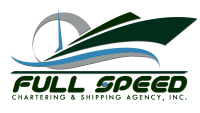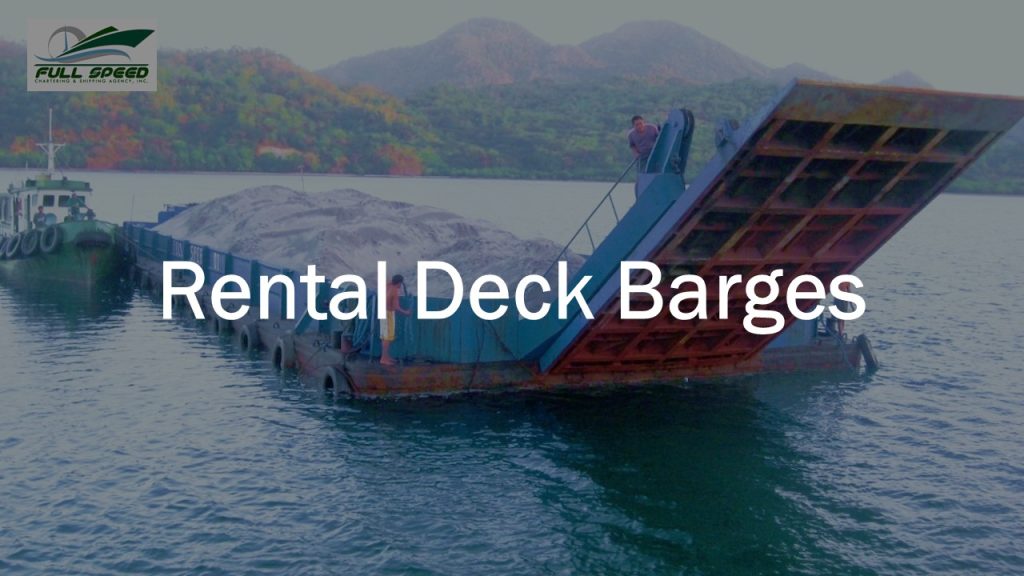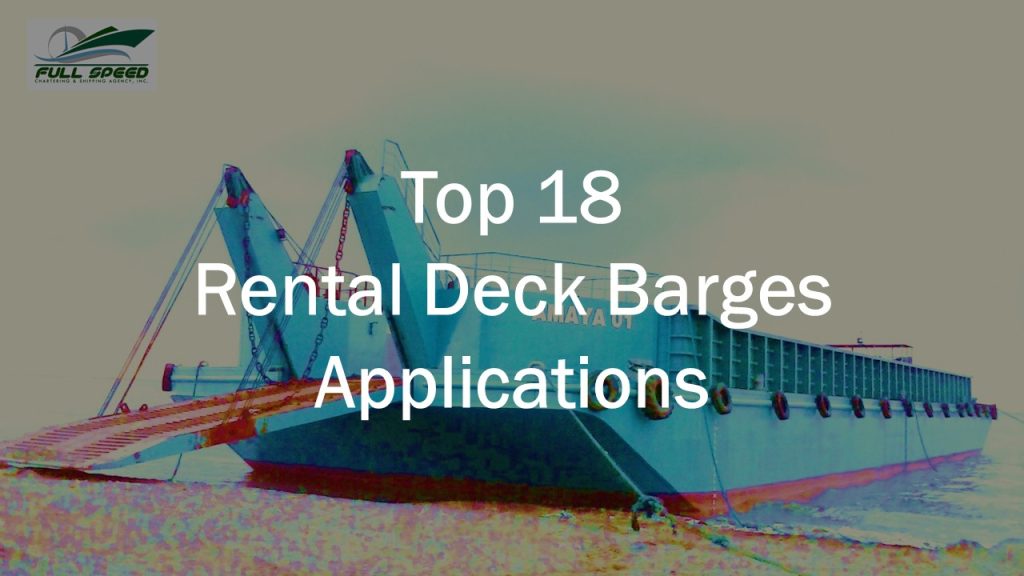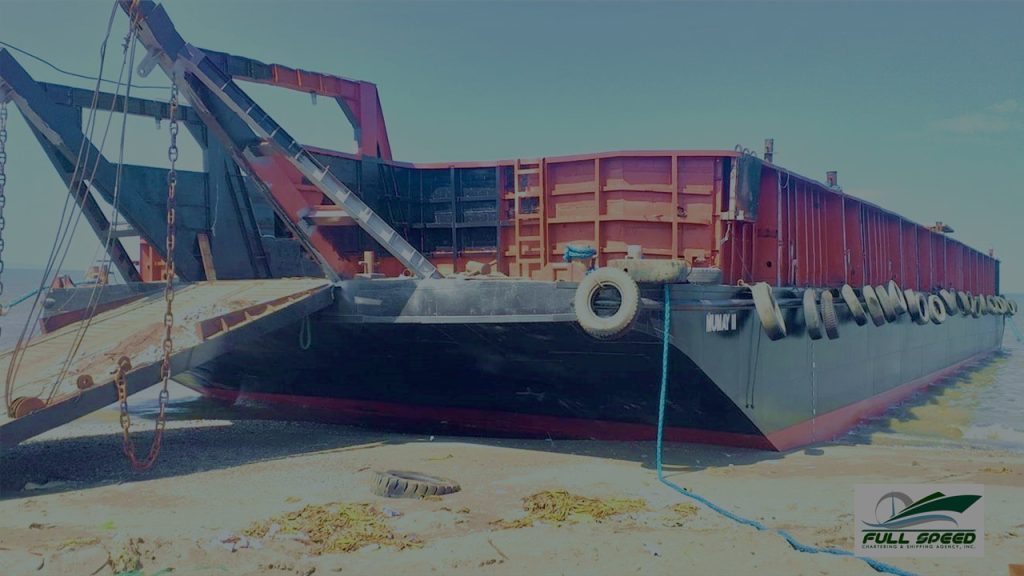Have you ever wondered how massive quantities of sand, rocks, and sediments are efficiently removed from water bodies? Enter the world of dredging vessels, the unsung heroes of coastal engineering. In the archipelago nation of the Philippines, where maintaining navigable waterways and combating erosion are crucial tasks, various types of dredging vessels play a vital role. From cutter suction dredgers to trailing suction hopper dredgers, each vessel has its own unique set of capabilities and functions. In this article, we will explore six different types of these fascinating machines that are reshaping the Philippine coastline.
Click here to view our barges, pontoons, and dredging capabilities.
Overview of Dredging Vessels and its Importance in the Philippines
Dredging vessels play a critical role in facilitating various maritime activities and ensuring the maintenance of waterways in the Philippines. These specialized ships are equipped with powerful machinery and tools to remove sediments, debris, and other obstructions from the seabed or riverbed. With the country’s numerous islands, rivers, and ports, dredging vessels are essential for maintaining navigable channels for commercial ships, fishing boats, and even leisure crafts.
Moreover, these vessels contribute significantly to marine ecosystems by restoring damaged habitats and preventing coastal erosion. By dredging sediment build-up along coastlines or harbors, these ships help maintain proper water depth levels necessary for healthy marine life while safeguarding infrastructure such as piers and jetties from degradation. Dredging also aids in flood prevention during heavy rain seasons by increasing water flow efficiency through rivers minimizing potential damage to nearby communities.
In addition to its practical applications, dredging plays a crucial role in supporting economic growth within the Philippines. The extracted sediments can often be repurposed for land reclamation projects or construction materials used in building roads or slopes. By effectively managing sediment transport dynamics with efficient dredging strategies, the country can enjoy improved navigational access while simultaneously utilizing resources responsibly.
In conclusion, understanding the importance of dredging vessels is paramount for developing sustainable maritime practices in the Philippines. These versatile ships not only ensure safe passage for various types of vessels but also protect coastal areas from erosion and support economic development through resource reutilization. As technology continues advancing, it is crucial for the Philippines to invest in modern dredging vessels that are equipped with state-of-the-art equipment and systems. By doing so, the country can enhance its dredging capabilities and effectively address the ever-evolving challenges posed by sedimentation.
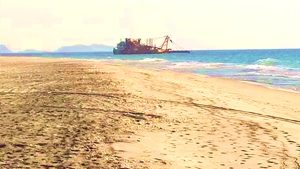
Here are the 6 Types of dredging vessels in the Philippines:
1. Cutter Suction Dredgers: Capabilities and Uses of these Dredging Vessels
One of the most capable and versatile dredging vessels in the Philippine maritime industry is the cutter suction dredger. This powerful vessel is specifically designed for precision excavation, making it an essential tool in various types of dredging projects. Equipped with a rotating cutter head, this dredger can cut through even the toughest materials like sand, clay, and rock.
The capabilities of a cutter suction dredger make it highly suitable for a wide range of uses. It is commonly employed for land reclamation projects to create new areas for infrastructure development or environmental preservation. In ports and harbors, these vessels are used to maintain navigational channels by removing sediment buildup that may impede shipping activities. Additionally, they play a crucial role in extracting minerals from underwater deposits and replenishing eroded beaches with fresh sand. With its immense power and versatility, the cutter suction dredger proves to be an indispensable asset in numerous coastal engineering endeavors across the Philippines.
These machines are built on robust platforms that can withstand harsh marine environments while effectively completing excavation tasks with utmost accuracy and efficiency. The advanced pumping systems onboard allow for optimum material transportation over long distances without compromising performance. Furthermore, many modern cutter suction dredgers are equipped with state-of-the-art automation technology that improves safety measures and enhances operational productivity.
Cutter suction dredgers possess exceptional capabilities that make them highly adaptable to various dredging needs. Their ability to precisely excavate different types of materials has led to their widespread use in critical infrastructural projects such as land reclamation, coastal protection, and the deepening of navigation channels. These dredgers are designed to handle a wide range of soil types, from soft silt and clay to dense sand and gravel.
In land reclamation projects, cutter suction dredgers play a crucial role in creating new land areas for development or expanding existing ones. By removing sediments from water bodies and depositing them in designated areas, these powerful machines help reshape coastlines and create valuable real estate for residential, commercial, or industrial purposes.
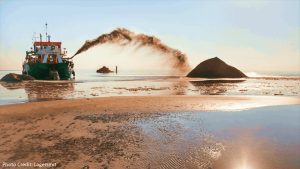
2. Trailing Suction Hopper Dredgers: Features and Applications of these Dredging Vessels
Trailing suction hopper dredgers (TSHDs) are impressive vessels that play a crucial role in dredging operations. Unlike other types of dredgers, TSHDs have the unique ability to both dredge and transport sediment. This versatility is made possible by their specially designed suction pipes and hoppers, which allow them to suck up sediment from the seabed and store it on board. Once filled, the hoppers can be emptied at designated disposal sites or used for reclamation purposes.
One of the standout features of TSHDs is their large carrying capacity. These vessels can typically carry anywhere from a few thousand cubic meters to tens of thousands of cubic meters of sediment. This makes them ideal for major port expansion projects, or beach nourishment works where large quantities of sediment need to be moved efficiently. Furthermore, their ability to unload without assistance allows for rapid turnaround times, enabling them to complete projects in a timely manner.
The applications for TSHDs are diverse and far-reaching. They can be used for capital dredging projects such as creating deep navigation channels or reclaiming land for infrastructure development. In addition, they are well-suited for maintenance dredging tasks like regular removal of accumulated sediments in ports and harbors to maintain safe navigation depths. The ability to work in different soil conditions, including fine sand and cohesive material like silt or clay, further adds to their versatility.
Trailing suction hopper dredgers also offer enhanced environmental sustainability compared to other forms of dredging. By utilizing a closed-loop system, they minimize the release of sediment plumes into the water, reducing potential harm to marine life and ecosystems. Moreover, some modern designs incorporate innovative technologies that allow for efficient separation and disposal of contaminants within the collected sediments. This ensures that any harmful substances, such as heavy metals or pollutants, are properly contained and disposed of in an environmentally responsible manner.
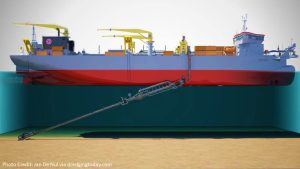
3. Bucket Wheel Dredgers: How these Dredging Vessels Operate and their Benefits
Bucket wheel dredgers are dredging vessels in the Philippines that operate by using large, rotating wheel-like structures with buckets attached to them. These buckets scoop up sediment and transfer it onto a conveyor belt, which then transports the material to either a storage area on board the vessel or directly onto shore. This method of operation allows bucket wheel dredgers to be highly efficient in removing large volumes of sediment.
One of the main benefits of bucket-wheel dredgers is their ability to navigate shallow waters with ease. Unlike other types of dredging vessels, bucket wheel dredgers have a low draft, which means they can access areas with limited water depth. This makes them particularly useful for maintenance dredging projects in ports and harbors where sediments accumulate over time and need to be removed periodically.
Furthermore, bucket wheel dredgers are known for their precise control over the amount and placement of excavated material. The rotation speed of the buckets can be adjusted based on the specific needs of each project, allowing operators to optimize performance and reduce wastage. This level of precision ensures minimal environmental impact during operations while maximizing productivity.
Overall, bucket wheel dredgers offer unique advantages compared to other types of vessels used in the Philippines’ coastal management projects. Their ability to operate in shallow waters, coupled with their precise control over-excavation, make them highly valuable for maintaining navigable channels and ensuring sustainable coastal development.
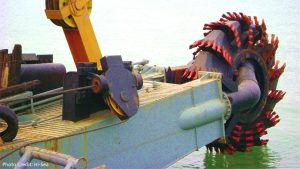
4. Backhoe Dredgers: Overview of this Versatile Dredging Vessel Equipment
Backhoe dredgers, also known as backhoes or excavators, are powerful vessels that play a crucial role in various dredging operations. Unlike other types of dredgers, backhoe dredgers have a versatile design that allows them to perform multiple tasks with ease. These vessels are equipped with an excavator mounted on the front end, which can be maneuvered to dig and scoop up sediments from underwater areas.
One of the key advantages of backhoe dredgers is their ability to execute precision excavation. The hydraulic arm attached to the vessel’s structure provides excellent control and dexterity, allowing operators to target specific areas for efficient removal of unwanted materials such as silt, sand, or rocks. This level of precision makes backhoe dredgers highly advantageous when carrying out maintenance work on ports or channels where accuracy is vital for maintaining navigational depths.
Furthermore, backhoe dredgers can easily switch between different working environments due to their detachable buckets. From removing sediment in rivers and lakes to deepening harbors and creating canals – these versatile vessels handle it all. Their adaptable nature also makes them ideal for shoreline replenishment projects where they can quickly transfer material from one location to another without causing significant disruptions.
Backhoe dredgers stand out among other types of dredging vessels due to their versatility and exceptional precision during excavation tasks. With their hydraulic arms and interchangeable buckets, they offer a wide range of industry-specific uses that make them invaluable in many submerged construction projects throughout the Philippines. Whether it is dredging Philippine rivers to improve navigation, excavating trenches for pipelines, or creating canals – these versatile vessels handle it all.
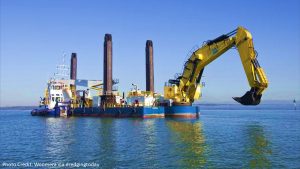
5. Water Injection Dredgers (Hydraulic dredgers): Working Mechanism and Benefits of these Dredging Vessels
Water injection dredgers, also known as hydraulic dredgers, are one of the most commonly used types of dredging vessels in the Philippines. These specialized ships play a crucial role in maintaining and deepening navigable waterways, ports, and harbors.
The working mechanism of water injection dredgers is relatively simple yet effective. Powered by onboard diesel engines, these vessels pump water under high pressure through a nozzle located at the bottom of the ship’s hull. This process creates a powerful jet of water that dislodges sediments from the seabed or riverbed. The mixture of sediment and water forms a slurry that is then transported to designated areas through pipelines or discharged directly into barges for disposal.
One major advantage of using water injection dredgers is their ability to operate without causing damage to marine ecosystems. Unlike traditional mechanical dredging methods, which can be damaging to coral reefs and other sensitive habitats, hydraulic dredging minimizes disruption to aquatic life and reduces turbidity in surrounding waters. Additionally, these vessels have excellent maneuverability, making them ideal for projects where precise positioning is necessary.
Moreover, since water injection dredgers rely on pumps rather than physical scooping or suctioning mechanisms like hopper or cutter suction dredgers do, they are able to work efficiently even in areas with rocky substrates. This versatility allows them to tackle various types of materials, including compacted soils and clay deposits, that would pose challenges for other types of equipment.
Water injection dredgers provide an efficient solution for maintaining and improving waterways, ports, and coastal areas. They play a crucial role in ensuring safe navigation for ships, preventing sediment buildup that can hinder vessel movement and pose risks to maritime activities.

6. Grab Dredgers: Uses and Advantages of these Dredging Vessels
Grab dredgers are one of the most versatile types of dredging vessels used in various applications. These vessels utilize a grab or bucket to scoop and remove materials from the seabed, including sand, mud, silt, and other debris. Grab dredgers are commonly employed for maintenance activities in ports and harbors, as well as for land reclamation projects.
One key advantage of using grab dredgers is their efficiency in extracting a wide range of materials. With their powerful hydraulic grabs and buckets, they can effectively handle different types of sediments with varying densities. This not only makes them suitable for shallow waters but also enables them to work efficiently in complex environments such as busy port areas or congested rivers.
Moreover, grab dredgers offer cost-effective solutions due to their ability to load material directly into barges or hopper barges parked alongside them. This eliminates the need for additional transportation equipment and reduces project costs significantly. In addition, grab dredging is generally considered an environmentally friendly method as it minimizes turbidity by extracting large volumes of sediments at once rather than continuously stirring up currents during operations.
Grab dredgers play a crucial role in various marine construction projects by efficiently removing sediments from water bodies with great precision. Their versatility allows them to adapt to different working conditions while offering cost-effective solutions for clients. As technology continues to advance in this field, we can expect even more innovative features and improved efficiency from these impressive vessels moving forward.
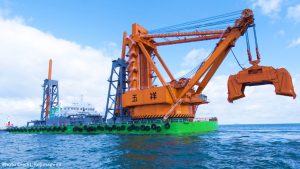
Do Dredging Vessels Require Barges? How Does It Work?
Dredging vessels are essential for maintaining and improving waterways, ports, and harbors. They play a crucial role in removing sediment and debris from the bottom of rivers, lakes, and oceans. But do these powerful machines require barges to assist them in their work? The answer is both yes and no.
In some cases, dredging vessels do require the assistance of barges. These barges serve as storage platforms for the sediment that is dredged up from the waterbed. Instead of disposing of this sediment back into the water or onto nearby land, it can be stored on a barge until it can be transported to an appropriate disposal location. This helps ensure that the waterway being dredged remains navigable and that environmentally friendly disposal practices are followed.
However, not all dredging vessels need barges to carry out their operations. Some modern dredgers have onboard storage compartments where they can store the removed sediment without needing a separate barge. These self-contained vessels are equipped with sophisticated systems that allow them to hold large amounts of material while continuing with their constant dredging operations.
Although some dredging vessels utilize barges for storing and transporting sediments, there are also advanced models available today that don’t require such assistance, thanks to their built-in storage capabilities. This highlights how technology continues to shape and improve various industries, including marine engineering and environmental stewardship, within the context of maintaining vital waterways.
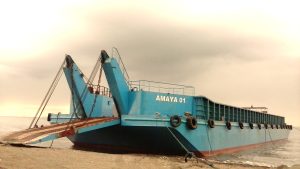
Are You Looking for Barges for Your Dredging Project in the Philippines?
Full Speed Chartering and Shipping Agency, Inc. (FSCSAI) is here to help you find the perfect barges for your dredging project in the Philippines. With their extensive fleet of vessels, they can provide cost-effective solutions that meet your specific requirements.
- Email us: info@fullspeedchartering.com
- Mobile, Viber, WhatsApp: +63 939 3753224
- Facebook Messenger: Click here
- Click here to inquire
Barges are widely used in dredging projects due to their versatility and capacity to transport large volumes of sediments. FSCSAI offers a range of barges, including plain deck barges, pontoon barges, and hopper barges. Each type serves different purposes, whether it’s dumping sediment offshore or transporting it for further processing.
What sets FSCSAI apart is its dedication to customer satisfaction and commitment to delivering high-quality services. They understand the unique challenges faced by clients during dredging operations and work closely with them to ensure the efficient execution of the project. By choosing FSCSAI for your barge needs, you can rest assured that you’ll receive reliable equipment that will help get your project done effectively and within budget.
So, if you’re looking for barges for your dredging project in the Philippines, don’t hesitate to contact Full Speed Chartering and Shipping Agency, Inc. Their expertise in maritime logistics combined with their diverse fleet make them the ideal choice for all your barge needs.
What are Dredging Vessels? How Can They Help the Philippine Government?
Dredging vessels play a crucial role in maintaining the navigability of waterways, channels, and ports in the Philippines. These specialized ships are equipped with powerful dredges that remove sediment and debris from the seabed, making it easier for ships to navigate safely. With over 7,000 islands and an extensive coastline, the Philippine government heavily relies on these vessels to ensure efficient maritime transportation and boost economic growth.
One significant way dredging vessels can help the Philippine government is through land reclamation projects. As an archipelagic nation facing problems like overcrowding and limited space for development, reclaiming land from coastal areas becomes a viable solution. Dredgers excavate sand from offshore locations and pump it onto designated areas along the shoreline to create new land masses. This reclaimed land can then be utilized for various purposes, such as building infrastructure, residential areas, or even leisure facilities – providing valuable opportunities for urban expansion and generating revenue through real estate development.
Moreover, dredging vessels contribute to environmental protection by engaging in sediment relocation operations. As rivers flow into oceans, they carry sediments laden with pollutants that can harm marine ecosystems. By dredging these riverbeds regularly not only does it improve navigation conditions for smaller boats but also helps prevent sediment buildup that hampers water quality and affects aquatic life downstream. Therefore, these vessels are essential tools in safeguarding both the economy and ecology of the Philippines’ coastal regions.
Dredging vessels brings immense benefits to the Philippine government by ensuring navigable waterways, protecting coastal communities from flooding, and maintaining the health of marine ecosystems.
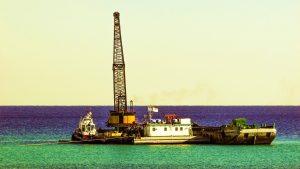
Key Features and Functions of Dredging Vessels in the Philippines
The key features and functions of dredging vessels in the Philippines play a crucial role in maintaining navigable waterways, reclaiming land, and preventing flooding. One of the prominent features is their powerful suction pumps that can extract large volumes of sediment from rivers, lakes, and harbors. These vessels are equipped with sophisticated GPS systems to accurately position themselves while dredging, ensuring precision and efficiency in their operations.
Dredging vessels also boast advanced technology that allows them to separate sediments from water using various methods, such as hydrocyclones or mechanical agitation. This ensures that the extracted material is thoroughly processed before disposal or reuse. Additionally, these vessels often come with clamshell buckets or grab arms that can be lowered into the water to collect loose material or debris from the seabed.
Furthermore, dredging vessels also have the capability to pump sediment over long distances using powerful pipelines. This enables them to transport dredged materials to designated areas for reclamation projects or beach nourishment. The ability of these vessels to efficiently remove silt and sand helps maintain shipping channels and prevent unexpected disruptions caused by reduced depths.
In conclusion, dredging vessels in the Philippines are specialized machines designed with essential features and functions tailored for efficient sediment removal. By employing state-of-the-art technology and equipment, these vessels contribute significantly to maintaining navigable waterways, protecting coastal areas against flooding risks, and supporting land reclamation projects throughout the country. Their versatility makes them indispensable assets in preserving marine environments while satisfying industrial demands for sustainable development in this sector. Additionally, these dredging vessels play a crucial role in supporting the country’s economy by facilitating efficient transportation of goods and materials through waterways.
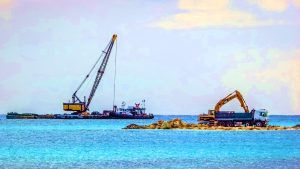
Applications and Industries that Use Dredging Vessels
Dredging vessels play a vital role in various applications and industries, making them indispensable in maintaining waterways and ensuring their optimal functionality. One primary application of dredging vessels is in harbor maintenance. As ports are essential hubs for trade and commerce, they require regular dredging to remove sediment build-up and maintain safe navigation channels for ships. Without effective dredging, harbors would become shallow and inaccessible, hindering economic activity.
Another industry that heavily relies on dredging vessels is the offshore oil and gas sector. These vessels are often used in the construction of offshore oil rigs by clearing seabed obstacles or creating trenches for pipeline installation. The ability to efficiently remove sediment allows these industries to extract resources from beneath the ocean floor successfully. Additionally, dredging vessels are also utilized in land reclamation projects where new land is created by filling coastal areas with materials such as sand or gravel.
Overall, the applications of dredging vessels range from maintaining harbors to facilitating offshore resource extraction and land reclamation projects. These versatile machines ensure that waterways remain navigable, supporting economic activities crucial to various industries. From building infrastructure to supporting trade routes, dredging vessels continue to play a pivotal role in shaping the world around us.
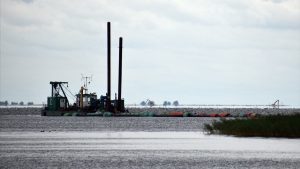
Dredging Vessels in the Philippine Construction Industry: Building Foundations and Land Reclamation
One of the most important aspects of construction projects is building a strong and stable foundation. In the Philippines, where land reclamation is a common practice due to limited available space, dredging vessels play a vital role in creating foundations for various infrastructure developments. These vessels are specifically designed to remove sediment and debris from bodies of water, enabling engineers to create solid ground where none existed before.
Land reclamation has been an effective solution for addressing the issue of limited space on densely populated islands in the Philippines. Dredging vessels are utilized to extract sand, silt, and rocks from nearby bodies of water like rivers or oceans. These materials are then deposited onto designated areas to build up land that can be used for urban development or other purposes such as agriculture or industrial facilities. Without these dredging vessels, it would be nearly impossible to reclaim land efficiently and effectively.
The construction industry in the Philippines heavily relies on the use of dredging vessels not only for land reclamation but also for maintaining existing infrastructure such as ports and harbors. Regular maintenance dredging is necessary to ensure proper navigation channel depth and prevent siltation that can lead to reduced water flow or blockage, which may disrupt activities related to trade and transportation. Additionally, these vessels also play an essential role in environmental preservation by removing pollutants from water bodies during the dredging process.
Dredging vessels serve as indispensable tools in the construction industry in the Philippines by facilitating land reclamation projects and maintaining existing infrastructure such as ports and harbors. Furthermore, these vessels are also utilized in the extraction of valuable resources from the seabed, such as sand, gravel, and minerals. These materials are essential for various construction projects and provide a sustainable source for meeting the growing demand for building materials.
In addition to their role in construction activities, dredging vessels also contribute to coastal protection and restoration efforts. They help combat erosion by replenishing beaches with sand that has been eroded over time due to natural processes or human activities. This helps maintain the integrity of coastal ecosystems and protects communities from the damaging effects of erosion and storm surges.

Dredging Vessels in the Mining Industry: Extracting Minerals from Underwater Deposits in the Philippines
One of the most fascinating aspects of the mining industry in the Philippines is its use of dredging vessels to extract minerals from underwater deposits. These massive machines are designed to navigate through rivers, lakes, and oceans, and they play a crucial role in uncovering valuable resources that would otherwise remain hidden beneath the water’s surface.
The diverse range of dredging vessels utilized in the Philippines includes suction dredgers, cutter suction dredgers, and trailing suction hopper dredgers. Each vessel is specifically equipped for different types of mining operations and ensures efficient extraction processes. The use of these vessels not only facilitates access to submerged mineral deposits but also minimizes environmental impact by removing sediment build-up that can disrupt aquatic ecosystems.
The presence of extensive underwater mineral reserves has made the deployment of dredging vessels an integral part of the mining industry in the Philippines. These advanced machines make it possible to reach depths previously considered inaccessible for resource extraction. By harnessing their power, miners have been able to tap into a wealth of minerals below sea level, opening up new opportunities for economic growth and development in the country.

Dredging Vessels in the Philippine Maritime Industry: Maintaining Navigable Waterways and Ports
In the Philippines, the maintenance of navigable waterways and ports is crucial for efficient maritime transportation and trade. Dredging vessels play a vital role in this process by removing sediment and debris from underwater areas to maintain adequate depth for shipping activities. These vessels are equipped with specialized equipment, including suction pipes or buckets, that can extract materials such as sand, silt, and rocks from the seabed.
One type of dredging vessel commonly used in the Philippine maritime industry is known as a trailing suction hopper dredger (TSHD). This vessel features large hopper compartments that can store and transport the dredged materials to designated disposal sites. With their ability to dredge large volumes of sediment at once, TSHDs significantly contribute to widening channels, clearing navigation pathways, and deepening berths in ports across the country.
Another important type of dredging vessel used in the Philippines is called a cutter suction dredger (CSD). Unlike TSHDs that operate in open waters, CSDs work more efficiently in confined spaces such as rivers, harbors, and estuaries. These robust vessels utilize a rotating cutter head mounted on a horizontal arm to excavate sediment and dislodge compacted material. The mixture of soil and water is then pumped through pipelines into barges or designated disposal sites. CSDs are particularly effective at maintaining river depths for inland navigation routes while mitigating potential flood risks during heavy rainfall seasons.
These various types of dredging vessels play an important role in maintaining and improving waterways for a variety of purposes. They are crucial in ensuring safe navigation for ships, promoting economic activities related to ports and harbors, and protecting coastal areas from erosion.

Dredging Vessels in the Philippine Environmental Industry: Restoring Ecosystems and Managing Sediments
When it comes to the environmental industry in the Philippines, dredging vessels play a crucial role in restoring ecosystems and managing sediments. These powerful machines are designed to excavate and remove underwater soil, sand, and debris from rivers, lakes, and other bodies of water. By doing so, they not only improve water quality but also ensure the safety of navigation routes for commercial vessels.
One of the key advantages of using dredging vessels is their ability to restore ecosystems that have been damaged due to sediment buildup. Sedimentation can significantly affect aquatic plant and animal life by reducing oxygen levels and blocking sunlight. Dredging removes excessive sediment, allowing water bodies to breathe again and flourish with diverse species. Moreover, this process is essential in preventing floods by increasing the capacity of natural channels to accommodate higher volumes of water during heavy rainfall events.
In addition to ecosystem restoration, dredging vessels also play a significant role in managing sediments in ports and harbors. As ships come into these areas for loading or unloading goods, they often stir up sediment at the bottom of water bodies. This can lead to dangerous siltation that affects shipping navigation channels. Dredging helps maintain safe depths for ships by removing accumulated sediments and ensuring smooth maritime operations.
Dredging vessels are an invaluable asset in the Philippine environmental industry as they contribute towards maintaining sustainable ecosystems and safeguarding critical navigation routes. By understanding their different types and capabilities within this context, stakeholders can make informed decisions on how best to utilize these powerful machines for the benefit of both the environment and the economy.
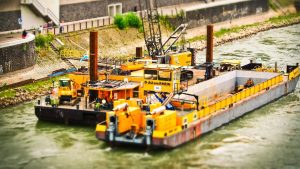
Dredging Vessels in the Oil and Gas Industry: Installing Pipelines and Platforms
Dredging vessels play a crucial role in the installation of pipelines and platforms in the Philippine oil and gas industry. These specialized vessels are designed to remove sediments, rocks, and debris from underwater areas to create a clear path for pipeline installation or platform construction. One such type of dredging vessel commonly used in the Philippines is the trailing suction hopper dredger (TSHD).
The TSHD is equipped with powerful pumps that create a vacuum, sucking up sediment from the seabed into its hopper. Once filled, it transports this material to designated dumping sites or is used for land reclamation purposes. This efficient process allows for rapid clearing of channels, ensuring smooth passage for laying pipelines or preparing foundations for offshore platforms.
Another important type of dredging vessel used in pipeline and platform installations is the cutter suction dredger (CSD). Unlike TSHDs, CSDs use rotating cutters at the suction inlet to loosen and dislodge compacted soils before pumping them out. This versatile vessel can work on various soil types, making it ideal for projects with varying site conditions.
These dredging vessels enable efficient installation of pipelines and platforms by creating navigable channels and providing stable foundations. Their precision engineering and adaptability make them essential assets in the demanding world of offshore oil and gas operations.
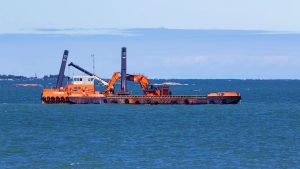
Benefits and Challenges of Using Dredging Vessels
Dredging vessels play a crucial role in various industries, such as construction, mining, and environmental management. One of the biggest benefits of using these specialized vessels is their ability to remove sediments and debris from bodies of water, ensuring improved navigability and reduced flood risks. Dredging vessels can effectively deepen harbors, channels, and rivers, creating more space for larger ships to dock and improving overall transportation efficiency. Additionally, they are instrumental in maintaining coastal areas by replenishing eroded beaches with sand gathered from elsewhere.
However, despite their numerous advantages, there are also significant challenges associated with using dredging vessels. One major challenge is the environmental impact they may have on aquatic ecosystems. Dredging activities can disturb marine habitats and disrupt the delicate balance of underwater ecosystems by releasing sediment into the water column or disturbing bottom-dwelling organisms. This disturbance can affect various species’ reproductive cycles and alter feeding patterns. Therefore, it’s crucial to carefully plan dredging projects in order to mitigate these negative impacts.
While dredging vessels undeniably offer substantial benefits like improved navigation and shoreline preservation when used correctly – their use also requires careful consideration of potential ecological consequences. By understanding both sides of this issue proactively, we will ensure sustainable practices that result in long-term benefits for both human populations and aquatic environments alike. wetlands into dredged areas can have significant ecological impacts. Wetlands are highly productive and diverse ecosystems that provide important habitats for many species of plants and animals. They serve as breeding grounds, feeding areas, and nurseries for numerous aquatic species.
Dredging in wetland areas can disrupt the delicate balance of these ecosystems. The removal of sediment can destroy important nesting sites for birds and disturb the underwater vegetation that serves as a food source for various organisms. Additionally, dredging activities can increase turbidity in the water, reducing visibility and limiting the ability of certain species to find food or navigate. This can have cascading effects on the entire food chain, ultimately impacting the overall health and abundance of wildlife in the area.

Latest Technological Advancements in Dredging Vessels in the Philippines
In recent years, the Philippines has witnessed remarkable advancements in dredging technology, showcasing its commitment to efficient and sustainable marine infrastructure development. One significant technological advancement is the use of automated dredging vessels that utilize Artificial Intelligence (AI) systems. These AI-powered vessels are equipped with advanced sensors and cameras that allow them to map underwater terrain accurately and identify potential obstacles such as rocks or debris. With precise mapping capabilities, these vessels can optimize their routes and minimize the risk of accidents, thereby ensuring safer operations.
Another noteworthy technological innovation in dredging vessels is the adoption of eco-friendly designs aimed at reducing environmental impact. For instance, some newly developed dredgers feature emission control technologies that significantly reduce air pollution caused by diesel engines. Moreover, these vessels are designed with systems that capture sediment particles before they are discharged back into the water, protecting marine ecosystems from potential harm. Such environmentally conscious designs not only comply with stringent regulations but also prioritize sustainability and contribute to maintaining a healthy balance between economic development and ecological preservation.
Furthermore, digitalization has played a crucial role in transforming the dredging industry in the Philippines. The integration of data-driven technologies enables real-time monitoring of various parameters such as sediment density, water flow rates, and vessel performance metrics. This allows operators to make informed decisions on the go regarding optimum dredging depths and locations for maximum efficiency while minimizing costs. Additionally, digital tools facilitate comprehensive data analysis for long-term planning strategies for coastal protection measures or port construction projects.
With these latest technological advancements in dredging vessels becoming more prevalent in the Philippines, the industry is experiencing a significant transformation.
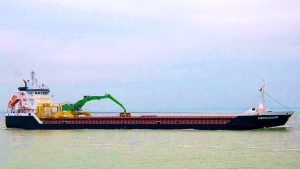
Takeaway: 6 Types of Dredging Vessels in the Philippines
In conclusion, the presence of six types of dredging vessels in the Philippines is a testament to the country’s commitment to improving its waterways and ensuring sustainable development. Each vessel serves a unique purpose, from cutter suction dredgers that remove sediment from riverbeds to trailing suction hopper dredgers that collect and transport material for disposal. The variety of dredging vessels available in the Philippines ensures that different types of projects can be undertaken, whether it’s deepening ports for larger ships or restoring mangrove ecosystems.
Moreover, the utilization of such diverse dredging vessels showcases how technology and engineering advancements have enabled more efficient and environmentally friendly methods of waterway maintenance. For example, environmental bucket ladder dredgers are equipped with eco-friendly components such as biodegradable hydraulic oil and low-emission engines. This demonstrates a holistic approach towards preserving marine life while improving navigability.
As the demand for infrastructure development continues to grow in the Philippines, the use of these six types of dredging vessels will become increasingly vital. It is essential for the government and private sector to collaborate in implementing proper regulations and guidelines to ensure safe and sustainable practices when it comes to using these vessels. By doing so, this archipelagic nation can continue to harness its natural resources while preserving its rich biodiversity for generations to come.
